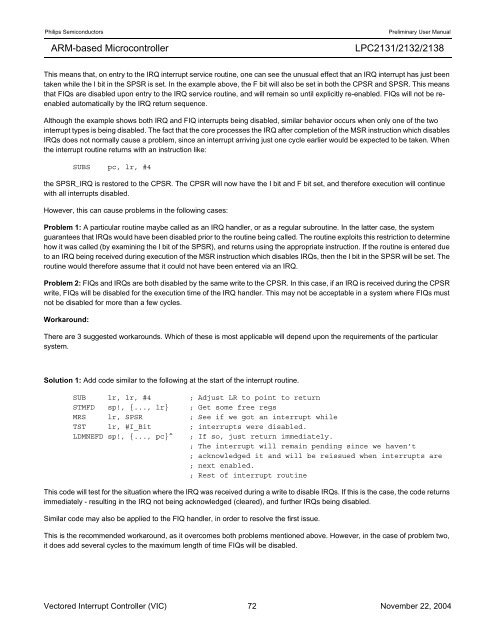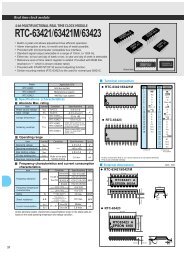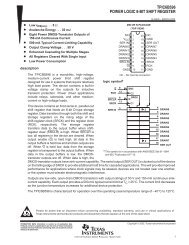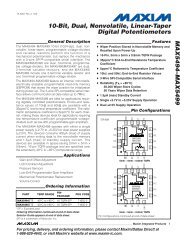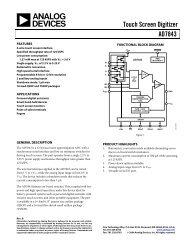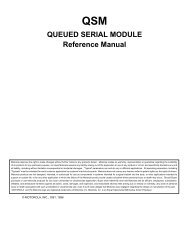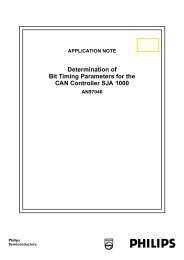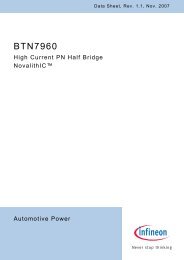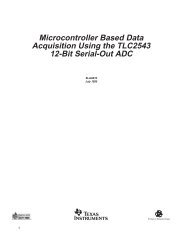Create successful ePaper yourself
Turn your PDF publications into a flip-book with our unique Google optimized e-Paper software.
Philips Semiconductors Preliminary <strong>User</strong> <strong>Manual</strong><br />
ARM-based Microcontroller<br />
<strong>LPC2131</strong>/<strong>2132</strong>/<strong>2138</strong><br />
This means that, on entry to the IRQ interrupt service routine, one can see the unusual effect that an IRQ interrupt has just been<br />
taken while the I bit in the SPSR is set. In the example above, the F bit will also be set in both the CPSR and SPSR. This means<br />
that FIQs are disabled upon entry to the IRQ service routine, and will remain so until explicitly re-enabled. FIQs will not be reenabled<br />
automatically by the IRQ return sequence.<br />
Although the example shows both IRQ and FIQ interrupts being disabled, similar behavior occurs when only one of the two<br />
interrupt types is being disabled. The fact that the core processes the IRQ after completion of the MSR instruction which disables<br />
IRQs does not normally cause a problem, since an interrupt arriving just one cycle earlier would be expected to be taken. When<br />
the interrupt routine returns with an instruction like:<br />
SUBS pc, lr, #4<br />
the SPSR_IRQ is restored to the CPSR. The CPSR will now have the I bit and F bit set, and therefore execution will continue<br />
with all interrupts disabled.<br />
However, this can cause problems in the following cases:<br />
Problem 1: A particular routine maybe called as an IRQ handler, or as a regular subroutine. In the latter case, the system<br />
guarantees that IRQs would have been disabled prior to the routine being called. The routine exploits this restriction to determine<br />
how it was called (by examining the I bit of the SPSR), and returns using the appropriate instruction. If the routine is entered due<br />
to an IRQ being received during execution of the MSR instruction which disables IRQs, then the I bit in the SPSR will be set. The<br />
routine would therefore assume that it could not have been entered via an IRQ.<br />
Problem 2: FIQs and IRQs are both disabled by the same write to the CPSR. In this case, if an IRQ is received during the CPSR<br />
write, FIQs will be disabled for the execution time of the IRQ handler. This may not be acceptable in a system where FIQs must<br />
not be disabled for more than a few cycles.<br />
Workaround:<br />
There are 3 suggested workarounds. Which of these is most applicable will depend upon the requirements of the particular<br />
system.<br />
Solution 1: Add code similar to the following at the start of the interrupt routine.<br />
SUB lr, lr, #4 ; Adjust LR to point to return<br />
STMFD sp!, {..., lr} ; Get some free regs<br />
MRS lr, SPSR ; See if we got an interrupt while<br />
TST lr, #I_Bit ; interrupts were disabled.<br />
LDMNEFD sp!, {..., pc}^ ; If so, just return immediately.<br />
; The interrupt will remain pending since we haven’t<br />
; acknowledged it and will be reissued when interrupts are<br />
; next enabled.<br />
; Rest of interrupt routine<br />
This code will test for the situation where the IRQ was received during a write to disable IRQs. If this is the case, the code returns<br />
immediately - resulting in the IRQ not being acknowledged (cleared), and further IRQs being disabled.<br />
Similar code may also be applied to the FIQ handler, in order to resolve the first issue.<br />
This is the recommended workaround, as it overcomes both problems mentioned above. However, in the case of problem two,<br />
it does add several cycles to the maximum length of time FIQs will be disabled.<br />
Vectored Interrupt Controller (VIC) 72 November 22, 2004


